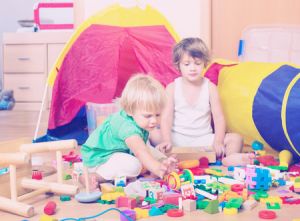The holiday season is a wonderful mix of sights and sounds, family and gift-giving, celebration and thanksgiving. It seems the season gets bigger, noisier and more hectic with each passing year. In fact, in addition to the increased volume of traffic, crowd noise and music during the holidays, some of the toys on the market today emit sounds so loud they can permanently damage hearing.
So as we scurry around trying to find the right present for each loved one, maybe it’s time to get back to basics. Instead of opting for things that whistle, ding, toot and entertain to wrap for our loved ones, think about giving one of these items from the Healthy Hearing Quiet Toy List. Each one generates noise levels well beneath the accepted healthy hearing levels of 70 decibels while providing a good measure of old-fashioned fun.
Gifts as quiet as normal breathing — 10 decibels

quiet toy list every year!
Books
Reading stimulates your mind, reduces stress, increases knowledge and vocabulary, improves memory and writing skills, and strengthens analytical thinking, focus and concentration. Since there are so many good books on the market to choose from, Healthy Hearing staff recommend these childhood favorites:
Paul Dybala, Ph.D. / president
“The Wild Robot,” by Peter Brown
As the father of two young boys, Paul recommends “The Wild Robot,” a story with a shipwreck, deserted island and a resourceful robot. Paul says the robot’s tenacity and propensity to do things the right way instead of the easy way is a “good metaphor for life, let alone being a Dad. It’s a process,” he said. “You don’t always know what to do next, you just have to figure it out, make some mistakes and learn from that. Taking the easy way out is tempting, but it rarely works out in the long run.”
If your kids like that book, you may want to read the sequel, too: “The Wild Robot Escapes.” Both are best-sellers on Amazon among the robot-loving crowd.
Susanne Jones, B.A., BC-HIS / customer support manager
“The Tracker,” by Tom Brown Jr.
Susanne is fond of being outdoors and her book selection reflects this. “The Tracker,” a book about the author’s experiences as an outdoorsman in New Jersey’s Pine Barrens forest, was one Susanne’s mother read aloud to her and her siblings when they were children. “To this day, I still think about the things I learned from this book when I am outdoors,” she said. “I feel it’s incredibly important, in this era of advanced technology and “screen-time” taking the place of actual playtime, that kids learn to understand and enjoy the great outdoors all around us. Appreciating nature helps us stay grounded.”
Mandy Mroz, Au.D. / director
“Mandy,” by Julie Andrews Edwards
Mandy admits she chose this book as a child because the title bears her name, but says she later fell in love with it because it tells the story of how an orphan eventually finds her forever family. “It’s a great story of adoption,” she said. “The main character is strong and independent and there’s some gardening thrown in! What’s not to love?”
Bill Talkington, Ph.D. / junior developer
“Goosebumps,” by R.L. Stine
Bill said he is really a non-fiction reader at heart, but fondly remembers reading the entire series of Goosebumps as an elementary school student when they first emerged. Bill’s suggestion to parents? Get your child a library card, take regular trips together and let your child decide which genre appeals most to them. “As a child,” he said, “I would regularly bring home a small stack of books from the public library, covering all sorts of topics.”
Natalina Raso, CDA / coordinator for Hearing Directory (Canada)
“The Berenstain Bears” books, by Mike Berenstain
Natalina, who said she’s been an avid reader all her life and never “shied away from a Scholastics catalog as a child,” fondly remembers reading this book series about an adorable family of bears first published in 1962 and the life lessons they teach. I absolutely adored these books,” she said. “The illustrations were colorful and the characters were relatable. It was very family-friendly and dealt with real-life day-to-day obstacles or learning curves that most children and families experience together. “The Berenstain Bears – In the Dark” helped me through my stages of being afraid of the dark and going to sleep as a child.”
Meditation
Schools across the country have begun teaching meditation as a way to improve mindfulness and increase respect for others. The movement is due to a series of studies which suggest mindfulness improves attention and behavior among children and youth. The good news? Meditation is something the whole family can practice together — and it’s free! Try these three kid-friendly meditations from the Chopra Center to get you started.
Gifts as quiet as normal conversation — 50 decibels
Building sets

a lot of benefit to growing children.
There are so many benefits to playing with construction toys, it almost warrants an article all by itself. Playing with blocks helps children learn shapes and colors, develop manual dexterity, patience, focus and encourages thinking and reasoning.
Beyond blocks, classic favorites include Lego, Tinkertoy, Lincoln Logs and K’nex. The best part of these gifts is their interactive nature. Many of these sets come with idea books which contain instructions for building basic items. They’re perfect for playing alone or collaborating with others. By the way, play dough counts as construction play too, so buy a couple of art smocks and let the squishing begin.
Handwork hobbies
Try string games. What benefit would anyone derive from playing with a piece of string? How about manual dexterity, concentration, memory, teamwork, patience, persistence and the fun of creating interesting patterns and designs using only your hands? Some patterns are simple, others can be intricate and complex. Some are created using two hands, while others involve more than one person. Most will be multi-generational topics of conversation the young can have with the young at heart.
The same can be said for hobbies such as knitting, crocheting and embroidery. Experts say crafts like these not only improve motor skills, they also stimulate the mind, reduce stress and provide a creative outlet. Put together a kit of tools for your favorite hobby or buy a “how-to” kit and learn together. You’ll both benefit from learning a new skill as well as spending quality time with each other.
Gifts as quiet as the sound of laughter — 60-65 decibels
Board games
If you grew up playing Candy Land and Chutes and Ladders, here’s some good news — these two board games are still popular among the toddler and preschool set. Besides the obvious benefits of playing board games together — fun family time, cognitive development and stress reduction — the laughter these games produce is like music for your ears. If you’re looking for a few new games to add to those old classics in the closet, may we suggest these fun options?
- Bananagrams — ages 7 and up. Use letter tiles to build a crossword grid creating as many words as possible in a race against others. Fun, portable and educational.
- Lift It! — ages 8 and up. Strap a plastic crane to your head and compete with family members to build structures before time runs out. Ridiculous? That’s what makes it so much fun!
- The Cat Game — You don’t have to be a cat lover to enjoy this ridiculously funny drawing game which involves a dry erase board, markers and a set of magnetic cats in hilarious poses. Suitable for teens and adults.
Card games
Card games have been around since the 15th century, but don’t let their age deter you. A deck of cards can provide hours of entertainment in the right hands, not to mention a host of physical and social benefits for adults and children. Chances are, you have a few of your own favorites. Here are a few of ours.
- Dr. Suess Cat in the Hat — ages 3 and up; promotes confidence, early reading skills, creativity and social skills
- Tabletopics family — ages 6 and up; promotes communication, conversational skills and thinking skills
- Uno — ages 7 and up; promotes strategy, numbers and colors
If you prefer old school games like Rummy and Go Fish, consider taking your card playing to an “astronomical” level by using Night Sky Playing Cards.
And now, a word about hearing loss
Today’s kids are exposed to more environmental noise than their parents or grandparents, due in part to the electronic gadgets they play with and elevated levels of industrial and recreational noise. According to the National Institute on Deafness and Other Communication Disorders (NIDCD), more than 16 percent of teens ages 12 to 19 say they have some hearing loss that may have been caused by exposure to loud noise.
What’s the good news? Noise-induced hearing loss is easily preventable. Some of the gifts on Healthy Hearing’s Quiet Toy List may sound familiar while others are new versions of old favorites, and they benefit more than just your hearing health. Our increasingly noisy world is ours alone to quiet, beginning with the gifts we give our families during the holidays.
If you suspect any member of your family, young or old, has hearing loss, seek the advice of a qualified hearing healthcare professional near you.
Editor’s note: In order to help us support our website and continue bringing our readers the latest information about hearing loss and hearing aids, this article contains affiliate links to products on Amazon.com.
